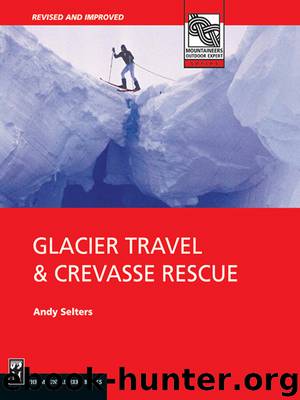Glacier Travel & Crevasse Rescue by Andy Selters

Author:Andy Selters
Language: eng
Format: epub
Publisher: The Mountaineers Books
SURFACE MEMBER PROCEDURES
As mentioned in the introduction, extracting someone from a crevasse can be a fairly technical operation. Before getting into the procedures for surface members it's important to understand two of its primary elements: anchors on a glacier and the basis of pulley hauling systems.
ANCHORS
As we've said, most crevasse falls occur where a glacier is covered with some sort of soft snow. This is the highly varying medium that glacier travelers usually have to depend on for anchors.
The ubiquitous anchor for summer snow is the deadman or fluke, a simple metal plate with attachment cables. It works on the principle that a broad surface buried in the snow will resist a force because to move it you'll have to move all the snow in front of it. Two simple features on a snow fluke increase its reliability many fold. First, a fluke vertically bent so the convex side faces the load will accommodate pulls slightly oblique to the fluke's plane. Second, a fluke's cables should be swaged with the upper cable longer than the lower, so that a simultaneous pull on the two cables leaves the fluke tilted back at 30 to 40 degrees from perpendicular to the pull. With this cant a fluke resists any pressure to rise out of the snow. Set properly, a fluke with these features will actually move through the snow like an airfoil when loaded, deflecting itself down and burying itself deeper: A loop of cord attached to a fluke can make it easier to retrieve once buried (see fig. 3.4).
To place a fluke well, you must first evaluate the snow. In typical old summer snow, you can simply dig the necessary trench (as outlined in this section), but in particularly slushy snow or in never-melted new snow you'll first need to prepare the placement area.
When the snow is quite slushy, you usually just need to scrape away and dig down to the inevitable firmer snow below. But in unmelted, relatively low-density snow, you'll need to simulate age hardening. Essentially this means you dig, overturn and generally upset the snow, then stomp and repack the area. Then, before you dig in to set the fluke, wait five minutes for the broken crystals to rebond into a denser, firmer medium.
One must be wary of placing flukes if there's an icy layer not far under the surface, for such a layer can deflect a fluke upward. The layer can be either an old melt-freeze layer of some sort, or the ice surface of the glacier itself, but in either case you should use another type of anchor.
With the snow ready, you now set your fluke:
With the adz of your ax, dig a 1-foot-long trench perpendicular to the load and about a foot deep. Angle this trench about 30 to 40 degrees from perpendicular to the snow surface, the angle of the fluke to its upper cable.
With the pick of your ax, slice out a slot from the middle of the trench running toward the load. This slot is for the fluke's cables, and should be as deep as the original trench.
Download
This site does not store any files on its server. We only index and link to content provided by other sites. Please contact the content providers to delete copyright contents if any and email us, we'll remove relevant links or contents immediately.
Annapurna by Maurice Herzog(3301)
Into Thin Air by Jon Krakauer(3132)
SAS Survival Handbook by John 'Lofty' Wiseman(2582)
The Ogre by Doug Scott(2506)
Reservoir 13 by Jon McGregor(2147)
Everest the Cruel Way by Joe Tasker(2133)
The End of Eddy by Édouard Louis(2054)
Touching the Void by Joe Simpson(1975)
The Push by Tommy Caldwell(1929)
Iced In by Chris Turney(1853)
The Isle of Mull by Terry Marsh(1806)
Miracle in the Andes by Nando Parrado(1793)
The Call of Everest by Conrad Anker(1788)
Touching the Void (1987) by Joe Simpson(1706)
Mud, Sweat, and Tears by Bear Grylls(1545)
Himalaya Bound by Michael Benanav(1509)
Higher Calling by Max Leonard(1475)
Death Grip by Matt Samet(1383)
Backcountry Bear Basics by Dave Smith(1360)
